To succeed at a deep-water wakeboarding start, choose the right equipment and a calm, obstacle-free spot, then focus on body positioning—knees bent, back straight, and weight centered. Hold the handle firmly with arms relaxed, and keep tension smooth but steady. Sit calmly in the water and prepare by engaging your core. As the boat slowly pulls you up, maintain balance and momentum. Keep practicing these steps, and you’ll improve your start with confidence.
Key Takeaways
- Choose proper equipment and calm water conditions for safety and control during the start.
- Maintain balanced body position with knees bent, back straight, and core engaged for stability.
- Hold the handle with firm, relaxed grip at shoulder height, pulling smoothly to initiate movement.
- Sit in the water with relaxed arms and knees slightly bent, then coordinate with boat acceleration for a smooth lift-off.
- Avoid rushing or pulling too hard; focus on steady technique, body alignment, and controlled tension for effective starts.
Choosing the Right Equipment and Location
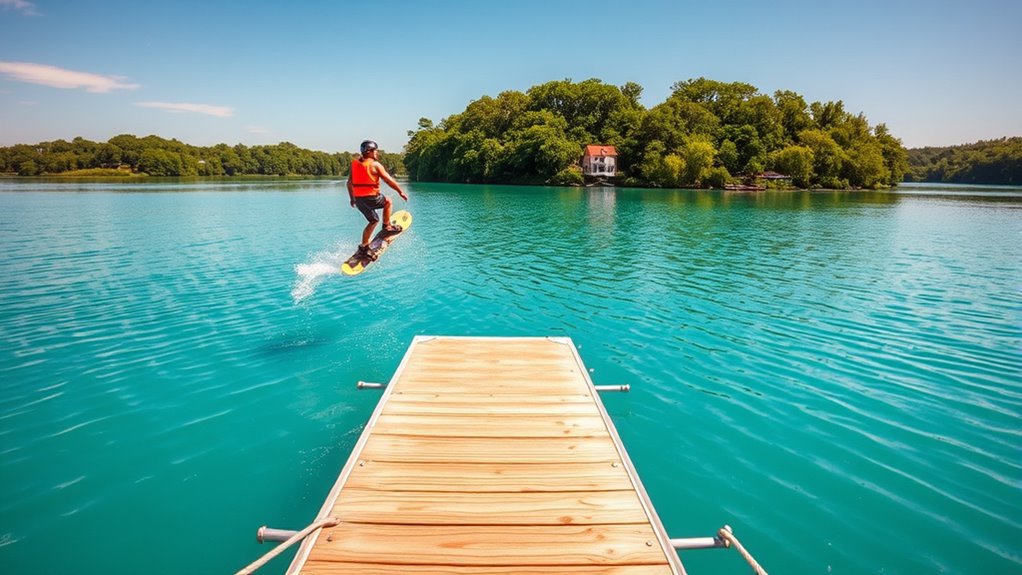
When selecting equipment and a location for deep-water wakeboarding, it’s essential to prioritize safety and suitability. Make sure your wakeboard is appropriate for your skill level, with the right size and bindings that fit snugly. Using a reliable, well-maintained tow rope is vital to avoid accidents. Choose a location with calm, clear water, free of debris, boats, and obstacles. Look for a spot designated for wakeboarding or water sports to guarantee safety measures are in place. Also, consider the depth; deep water is safer for beginners, reducing the risk of hitting the bottom. Check weather conditions and avoid windy days or storms. Proper equipment and a safe location set the foundation for a successful and enjoyable wakeboarding experience.
Proper Body Position and Balance
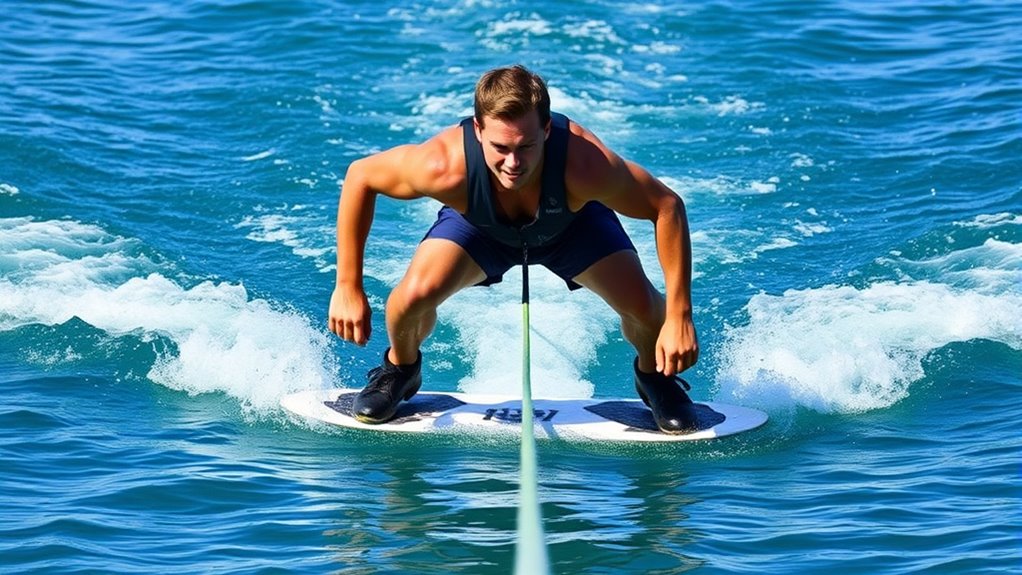
Having the right equipment and choosing a safe location are important, but maintaining proper body position and balance is what keeps you upright and steady on the water. To stay balanced, keep your knees slightly bent, your back straight, and your weight centered over the board. Engage your core for stability, and look straight ahead rather than down. Proper positioning helps you respond quickly to water shifts and maintain control during the start. Here’s a quick guide:
| Body Part | Positioning Tip | Purpose |
|---|---|---|
| Knees | Slightly bent | Absorbs shocks, maintains balance |
| Shoulders | Level and facing forward | Keeps control and stability |
| Hips | Over the board | Prevents falling back or forward |
| Head | Up and looking ahead | Aids balance and orientation |
| Feet | Shoulder-width apart | Provides stability and control |
Additionally, practicing body awareness can significantly improve your ability to stay balanced and respond to water movements effectively. Developing a strong sense of body positioning can enhance your overall wakeboarding skills and help prevent falls. Being aware of your center of gravity is essential for maintaining stability, especially during sudden water shifts. Incorporating flexibility exercises can also improve your range of motion, making it easier to adapt to unexpected water movements and reduce injury risk.
Using the Rope and Handle Correctly

To ride smoothly, you need to hold the rope and handle correctly. Keep your hands in proper placement, stay aware of rope tension, and make sure your movements are smooth. These key points help you maintain control and ride with confidence. Being familiar with proper disposal practices can also prevent issues with your equipment or environment, ensuring a safer and more enjoyable experience. Additionally, understanding how to manage essential oils for respiratory health can support your overall well-being during physical activities. Using the right techniques for equipment tuning can further enhance your riding experience, making your wakeboarding sessions more effective and fun. Remember that the Horsepower of Electric Dirt Bikes can influence your riding experience, so choosing a bike with appropriate power helps you stay in control and perform better on the water. Proper tuning techniques can optimize your equipment’s performance, making your wakeboarding sessions more effective and fun.
Proper Hand Placement
Proper hand placement is essential for maintaining control and stability while wakeboarding. Grip the handle with both hands, keeping your palms down and thumbs wrapped around it. Your hands should be shoulder-width apart to create a balanced hold. Avoid gripping too tight, as this can cause fatigue, or too loose, which can lead to loss of control. Keep your arms slightly bent and relaxed to absorb shocks and maintain flexibility. Position the handle in front of your hips, not too high or low, to stay in a comfortable, natural riding stance. Consistent hand placement helps you respond quickly to the boat’s movements and keep your balance. Practicing proper grip ensures better control and smoother starts, especially during deep-water launches.
Maintain Rope Tension
Maintaining consistent rope tension is essential for smooth wakeboarding, especially in deep water. It helps you stay balanced and keeps the boat’s pull steady. To do this, focus on these key points:
- Keep your arms slightly bent and relaxed, avoiding stiff grips.
- Pull the handle smoothly toward your hips, not jerking or pulling too hard.
- Stay in a low, athletic stance to absorb the tension naturally.
- Communicate with the driver if tension feels uneven, so they can adjust speed accordingly.
- Being aware of your data privacy and how data is collected can help you make informed decisions about your wakeboarding experience.
Use Smooth Movements
Using smooth movements with the rope and handle is key to maintaining control and flow while wakeboarding. Keep your arms steady and avoid jerky motions, which can disrupt your balance. When pulling yourself up or steering, use gradual, controlled pulls rather than sudden yanks. Focus on fluid, consistent movements to stay aligned with the boat’s pace. This helps you stay relaxed and connected to the rope, making it easier to respond to changes in water conditions. Practice handling the handle smoothly during your starts and turns, ensuring your posture remains stable. Remember, the goal is to move with the water’s rhythm, not against it. Nail styles with smooth, deliberate motions will give you better control and help you progress faster on the water. Additionally, understanding tuning principles can help optimize your wakeboarding setup for better performance and comfort.
Techniques for Sitting and Preparing in the Water
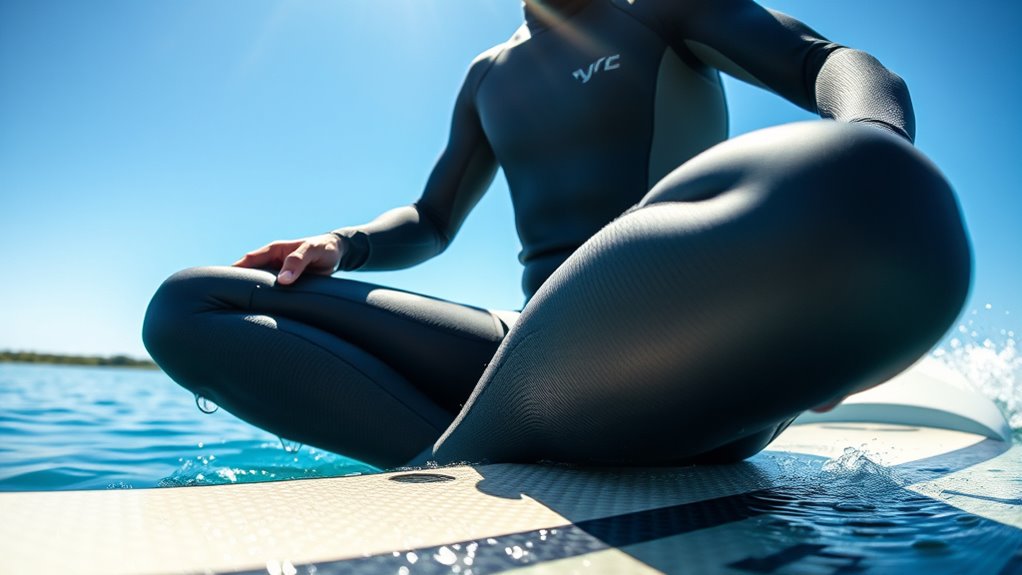
Before you start preparing to wakeboard, it’s important to sit calmly in the water to establish a stable position. This helps you stay balanced and ready for the pull. Keep your knees slightly bent and your arms relaxed. Focus on maintaining a centered posture, keeping your weight evenly distributed. To set up efficiently, follow these steps:
- Relax your body and hold onto the tow rope with both hands.
- Keep your head up and look forward, not down.
- Align your hips with the boat’s direction.
- Engage your core muscles to stay steady.
- Being aware of family photoshoot fails can remind you to stay relaxed and have fun with the process.
Staying relaxed and focused helps you conserve energy and prepare for a smooth start. Practice sitting still and maintaining your balance in the water before attempting the actual pull.
Executing a Smooth and Controlled Pull
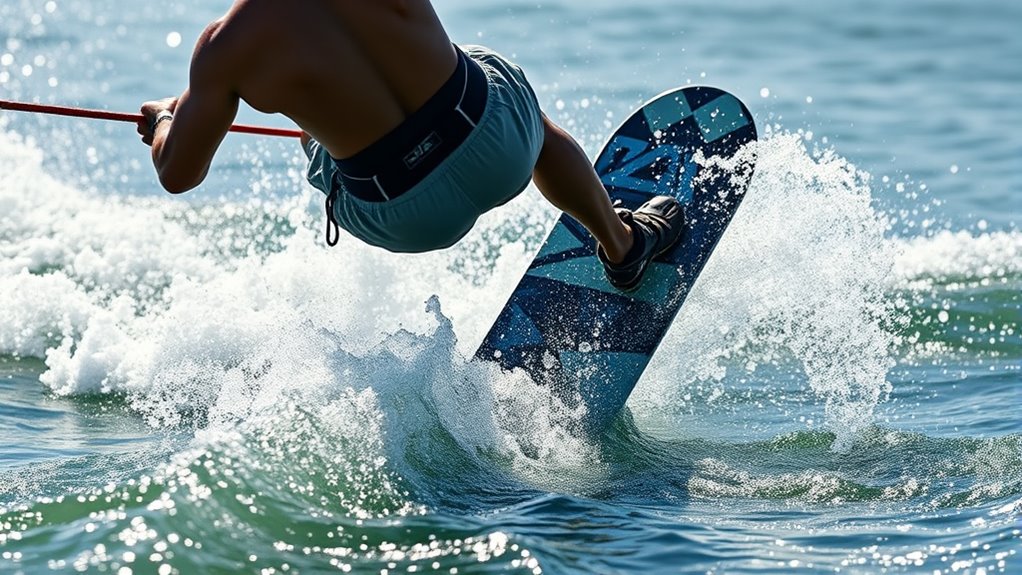
To execute a smooth and controlled pull, focus on maintaining proper body position throughout the maneuver. Use gentle, consistent pressure on the rope to avoid jerking or losing balance. This approach helps you stay stable and makes your wakeboarding experience more enjoyable. Incorporating proper technique can further enhance your control and confidence during deep-water starts. Developing leadership skills such as focus and adaptability can help you better respond to different water conditions and improve your overall performance. Paying attention to body positioning can also optimize your balance and stability during the start, especially when combined with real-time data analytics to adjust your technique accordingly.
Maintain Proper Body Position
Maintaining proper body position during your wakeboarding pull is essential for a smooth and controlled ride. Keep your body centered over the board, with knees slightly bent to absorb shocks and maintain balance. Engage your core to stay stable and avoid leaning back or forward excessively. Your arms should stay relaxed but firm, with your hands directly in front of you. Keep your hips aligned with the board to help with directional control. Focus on a steady, even pull, avoiding sudden jerks. This posture helps you stay balanced and responsive, making your ride more enjoyable and safe. Proper body alignment is key to mastering wakeboarding techniques. Additionally, being aware of your body positioning can significantly improve your overall control and confidence on the water. Remember that hydrotherapy techniques, such as aquatic exercises, can enhance your core strength and stability, further benefiting your wakeboarding skills. Practicing water-based exercises can also improve your flexibility and resilience on the water.
Use Gentle, Consistent Pull
A smooth and controlled pull is essential for a safe and enjoyable wakeboarding experience. As you start, keep your arms relaxed and focus on steady tension on the rope. Avoid jerking or pulling too hard, which can cause instability or falls. Instead, apply gentle pressure, gradually increasing as you gain momentum. Maintaining a consistent pull helps keep your board and body aligned, making it easier to stay balanced. Think of your pull as a steady rhythm rather than a sudden tug. This controlled approach allows you to accelerate smoothly and maintain better control throughout the start. Remember, patience is key—rushing can lead to losing your balance. With practice, your pulls will become more fluid, helping you enjoy a safer, more confident wakeboarding experience.
Maintaining Momentum and Stability During the Start
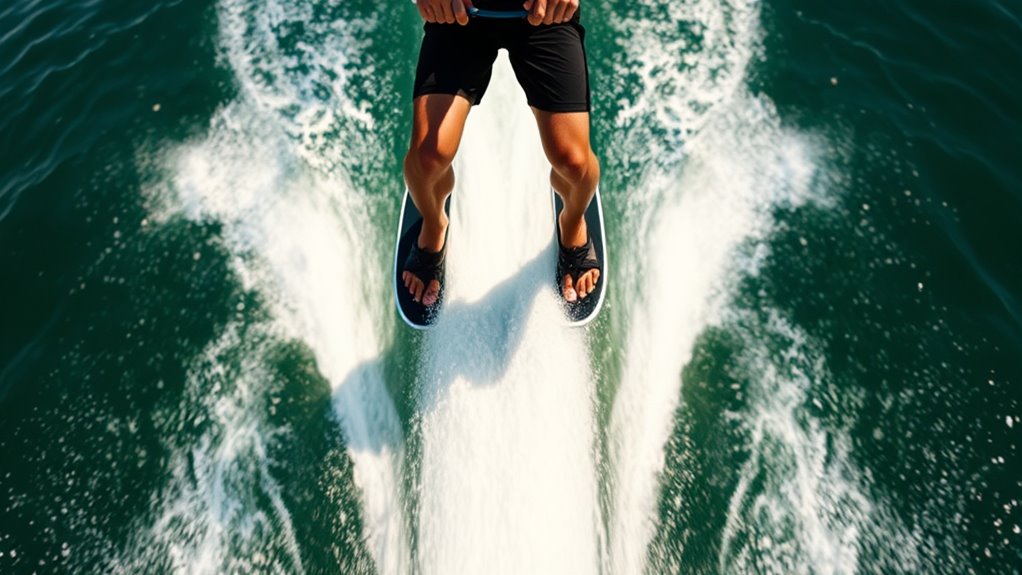
Getting off to a smooth start requires focusing on your body positioning and timing. To maintain momentum and stability during the start, keep your weight centered over the board and stay relaxed. This helps you stay balanced as you accelerate. As the boat pulls you forward, engage your core and keep your knees slightly bent to absorb shocks. Here are four key tips:
- Keep your arms straight and hold the handle firmly.
- Lean back slightly to counteract the pull and avoid tipping forward.
- Look straight ahead, not down, to help maintain balance.
- Coordinate your movements with the boat’s acceleration for a smooth lift-off.
Staying composed and focused will help you stay stable, making it easier to build momentum for a successful wakeboarding ride.
Common Mistakes to Avoid for a Successful Launch

One common mistake to watch out for is letting your arms bend or loosen during the start, which can cause instability and reduce control. Keep your arms straight and firm to maintain a steady pull on the rope, helping you stay balanced. Avoid pulling too hard too soon, as it can cause you to lurch backward or lose your position. Also, don’t lean back excessively; instead, try to keep your weight centered over the board. Another mistake is rushing the start; wait until the boat pulls you gently forward before applying your weight to stand up. Staying relaxed and focused helps you react smoothly. By avoiding these errors, you’ll improve your chances of a clean, confident deep-water start.
Frequently Asked Questions
How Do Weather Conditions Affect Deep-Water Wakeboarding Starts?
Weather conditions play a big role in your wakeboarding start. If it’s windy, you might struggle with control and balance, making it harder to get up smoothly. Calm, clear days make it easier because the water is more stable and predictable. Cold temperatures can stiffen your muscles, so you should warm up properly. Always check the weather forecast before heading out to guarantee safe and successful deep-water starts.
What Safety Gear Is Recommended for Deep-Water Starts?
Imagine giving yourself the best possible shield before diving into the thrill. You should always wear a life jacket designed for wakeboarding, ensuring buoyancy and freedom of movement. A helmet is your best friend, protecting your head during unexpected tumbles. Consider a wetsuit if water’s chilly, and gloves for grip. Safety gear keeps you confident, so you can focus on enjoying the ride and mastering those deep-water starts.
How Can I Improve My Confidence During a Deep-Water Start?
To boost your confidence during a deep-water start, focus on staying relaxed and positive. Practice your balance and body positioning on land first, then gradually progress in the water. Visualize success before each attempt, and don’t rush the process. Remember, every fall is part of learning. With patience and practice, you’ll build trust in your abilities and gain confidence to perform deep-water starts smoothly and confidently.
What Are Signs of Fatigue Affecting Start Performance?
Ever feel like you’re running out of steam, like a dial-up internet connection? Signs of fatigue affecting your start include shaky movements, difficulty holding the rope, and a lack of focus. Your muscles may feel heavy, and your timing could be off. If you notice these signs, it’s time to rest, hydrate, and recharge. Pushing through fatigue will only compromise your performance and safety during the wakeboarding start.
How Do I Recover if I Fall During the Start?
If you fall during the start, stay calm and keep hold of your board. Signal the boat to stop or slow down, then float on your back if needed to catch your breath. When you’re ready, retrieve your board and get back in position quickly. Focus on resetting your stance and taking deep breaths to regain confidence before trying again. Remember, falls happen, and quick recovery keeps you moving forward.
Conclusion
Mastering a deep-water start takes practice and patience, but don’t get cold feet. Stay focused on your technique, keep your body steady, and follow the tips to set yourself up for success. Remember, the early bird catches the worm, so be prepared and confident from the get-go. With time, you’ll find yourself smoothly gliding across the water, proving that perseverance is key to turning beginners into pros.










